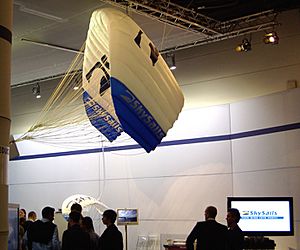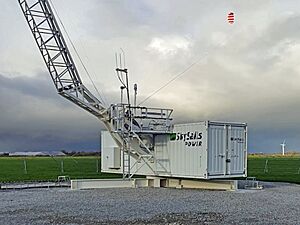SkySails facts for kids
| Founded | 2001 |
|---|---|
| Founders |
|
| Headquarters |
,
Germany
|
|
Number of employees
|
150 (2021) |
SkySails Group GmbH is a company from Hamburg, Germany. They create special kite rigs that help big ships, like cargo ships, large yachts, and fishing boats, move using wind power. They also make systems that use kites high in the sky to create electricity from strong winds.
Contents
What SkySails Does
SkySails Group GmbH started in 2001. It was founded by Stephan Wrage and Thomas Meyer in Hamburg. The company's main goal is to use wind power to help ships and create electricity.
Even though their technology helps save fuel and reduce pollution, the company has faced some challenges. For example, ship owners might not always want to invest in new technology if they don't pay for the fuel themselves. Also, there haven't been many rules about pollution for ships, and fuel prices have sometimes been low.
In 2012, the company had to reduce its staff. Later, in 2016, the original SkySails GmbH had to reorganize. However, SkySails Group GmbH continued the work. They also started a new part of their business called SkySails Power.
The company's main office is in Hamburg. The parts for their wind energy systems are put together in Lower-Saxony, Germany.
Kite Systems for Ships
SkySails makes a special system that uses giant kites to pull ships. This helps ships save fuel and reduce harmful gases released into the air.
How the Ship Kite Works
The SkySails system for ships uses a large, automatically controlled kite. These kites can be hundreds of square meters in size. There's also an electronic system to control the kite and a way to pull it back in when not in use.
These kites are much bigger than the ones used for kitesurfing, but they work in a similar way. They create a lot more pulling power than regular sails. A special control pod helps steer the kite. Only one strong line connects the kite to the ship. This line also sends power and commands to the control pod.
To launch the kite, a special mast or arm holds it. This arm also helps inflate and deflate the kite. When the kite is not being used, the mast and deflated kite fold away neatly.
A ship with a SkySails system uses less fuel. It also has two ways to move, making it a type of hybrid vehicle. Using these kites can save a lot of carbon emissions each year. This is like reducing the amount of pollution that goes into the air.
Ships Using SkySails
The Wessels Shipping Company worked with SkySails to test the system on their ship, the MV Micheal A., in 2007. They liked it so much that they ordered more systems. One of these was added to the MV Theseus.
The MS Beluga SkySails was the first ship built specifically to use this system. It was launched in December 2007. This ship was 132 meters long and weighed 10,000 tonnes. It had a 160 square meter kite. In January 2008, it sailed from Germany to Venezuela.
The ship finished its journey in March 2008. It sailed from Germany to Venezuela, then to the United States, and finally to Norway. When the kite was used, the ship saved about 10-15% on fuel. This meant saving around $1,000 to $1,500 every day.
Over a year, on routes with good winds, the system can save about 5.5% of fuel.
In 2010, SkySails sold a system for the Maartje Theadora. This was the first time a SkySails system was used on a fishing trawler. The Maartje Theadora is Germany's largest fishing ship. The kite helps reduce fuel costs when the ship travels to fishing areas.
Even though these systems save fuel and reduce pollution, they haven't been used by many ships yet.
Kites for Making Electricity
SkySails Power GmbH was started in 2015. This part of the company focuses on using kites to make electricity. A test power plant in Schleswig-Holstein has been running since late 2019.
How the Power Kite Works
The power kite is controlled automatically. It flies in a figure-eight pattern, driven by the wind. As the kite goes higher, it pulls a rope from a winch on the ground. This pulling force turns a generator inside the winch, which creates electricity.
When the rope reaches its longest point (up to 800 meters), the kite's autopilot moves it into a position where it doesn't pull much. Then, the generator acts like a motor and pulls the rope back in. The system repeats this process over and over. The kite usually flies between 200 and 400 meters high. The electricity made by this system can be sent to the power grid, stored in batteries, or used right away.
"SkyPower100" Test Project
The power kite system in Schleswig-Holstein is part of a research project called "SkyPower100." This project is supported by the German government. SkySails Power GmbH is working with other companies and a university on this project. They want to learn more about how these systems work. They also study things like noise, how it affects birds, and air traffic safety.
See also
 In Spanish: SkySails para niños
In Spanish: SkySails para niños




